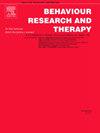衡量对社会压力源的行为反应:社会表现评定量表是否具有超越社交焦虑障碍的效用?
IF 4.2
2区 心理学
Q1 PSYCHOLOGY, CLINICAL
引用次数: 0
摘要
社会表现评定量表(Social Performance Rating Scale,简称SPRS)是指在社会环境中表现出的焦虑行为。尽管SPRS几乎专门用于研究社交焦虑障碍(SAD),但其他情绪障碍也以对社交压力源的反应增强为特征,这表明SPRS可以作为行为焦虑的跨诊断状态测量。为了探索这种可能性,患有广泛性焦虑障碍或重度抑郁症的成年人(n = 105)和没有精神病理的成年人(n = 35)向模拟行为专家委员会发表了演讲。在演讲过程中观察到的行为焦虑使用SPRS评分,然后检查与临床和状态焦虑和抑郁的关系。与我们的假设相反,行为焦虑与临床医生或自我评估的焦虑或抑郁严重程度无关。相反,那些特别害怕和避免公开演讲的人的行为焦虑会加剧;他们认为演讲任务压力更大;在演讲时,他们报告了更多的情绪困扰,身体亢奋,焦虑和悲观的想法。SPRS是一种有效的焦虑行为测量方法,适用于在社会评价环境中经历急性焦虑的许多个体,无论有无SAD。由于行为测量的收集是资源密集型的,因此需要进行研究,以确定SPRS是否能预测现实环境中的焦虑行为和功能障碍,而不是更容易获得的自我报告测量。本文章由计算机程序翻译,如有差异,请以英文原文为准。
Measuring behavioral responses to a social stressor: Does the Social Performance Rating Scale have utility beyond social anxiety disorder?
The observer-rated Social Performance Rating Scale (SPRS) indexes anxious behaviors exhibited in social contexts. Although the SPRS has been used almost exclusively to study social anxiety disorder (SAD), other emotional disorders are also characterized by heightened responses to social stressors, hinting that the SPRS could serve as a transdiagnostic state measure of behavioral anxiety. To explore this possibility, adults with generalized anxiety disorder or major depressive disorder (n = 105) and adults with no psychopathology (n = 35) delivered a speech to a committee of mock behavioral experts. Behavioral anxiety observed during the speech was rated using the SPRS, then examined in relation to clinical and state measures of anxiety and depression. Contrary to our hypotheses, behavioral anxiety was not associated with clinician- or self-rated anxiety or depression severity. Instead, behavioral anxiety was heightened among individuals who specifically fear and avoid public speaking; who perceived the speech task to be more stressful; and who reported more emotional distress, somatic hyperarousal, and anxious and pessimistic thoughts at the time of the speech. The SPRS is a valid measure of anxious behavior in the many individuals, with and without SAD, who experience acute anxiety in social-evaluative contexts. As behavioral measures are resource-intensive to collect, research is needed to establish whether the SPRS predicts anxious behavior and functional impairment in real-world settings, over and above easier-to-obtain self-report measures.
求助全文
通过发布文献求助,成功后即可免费获取论文全文。
去求助
来源期刊

Behaviour Research and Therapy
PSYCHOLOGY, CLINICAL-
CiteScore
7.50
自引率
7.30%
发文量
148
期刊介绍:
The major focus of Behaviour Research and Therapy is an experimental psychopathology approach to understanding emotional and behavioral disorders and their prevention and treatment, using cognitive, behavioral, and psychophysiological (including neural) methods and models. This includes laboratory-based experimental studies with healthy, at risk and subclinical individuals that inform clinical application as well as studies with clinically severe samples. The following types of submissions are encouraged: theoretical reviews of mechanisms that contribute to psychopathology and that offer new treatment targets; tests of novel, mechanistically focused psychological interventions, especially ones that include theory-driven or experimentally-derived predictors, moderators and mediators; and innovations in dissemination and implementation of evidence-based practices into clinical practice in psychology and associated fields, especially those that target underlying mechanisms or focus on novel approaches to treatment delivery. In addition to traditional psychological disorders, the scope of the journal includes behavioural medicine (e.g., chronic pain). The journal will not consider manuscripts dealing primarily with measurement, psychometric analyses, and personality assessment.
 求助内容:
求助内容: 应助结果提醒方式:
应助结果提醒方式:


